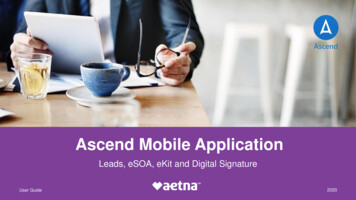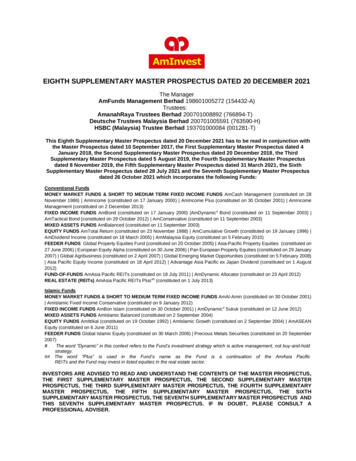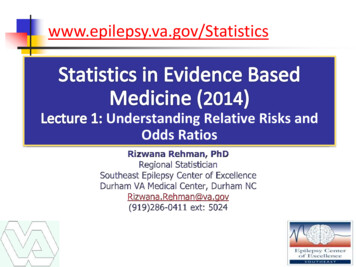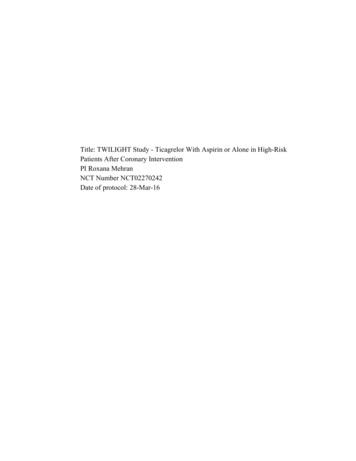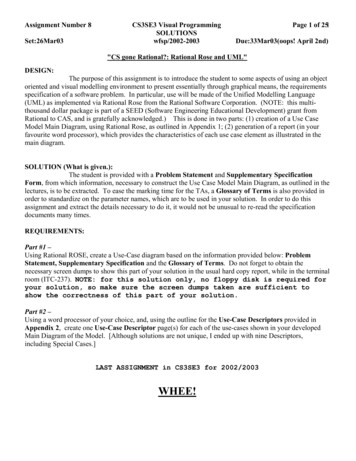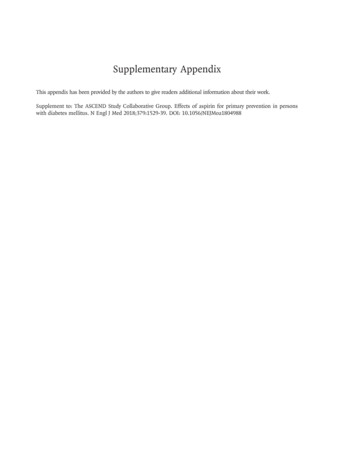
Transcription
Supplementary AppendixThis appendix has been provided by the authors to give readers additional information about their work.Supplement to: The ASCEND Study Collaborative Group. Effects of aspirin for primary prevention in personswith diabetes mellitus. N Engl J Med 2018;379:1529-39. DOI: 10.1056/NEJMoa1804988
Supplementary appendix: Effects of aspirin for primary prevention in people with diabetesEffects of aspirin for primary prevention in people with diabetesSupplementary AppendixContentsMembers of ASCEND Study Collaborative Group. 3Writing Committee . 3Steering Committee . 3Data Monitoring Committee . 3Senior Management Team . 3Coordinating Office (Clinical Trial Service Unit, Nuffield Department of Population Health,University of Oxford): . 3Supplementary Methods . 6Recruitment . 6Post-randomization follow-up . 7Post-randomization sampling . 7Statistical analysis . 8Primary and secondary outcomes. 10Primary safety assessment . 10Adherence to study treatment . 11Baseline vascular risk score and predicted absolute effects with full adherence . 11Definition of events and adjudication . 12Myocardial infarction (MI) . 13Stroke. 13Transient ischemic attack (TIA) . 14Coronary and non-coronary revascularisation . 14Cancer . 14Amputation . 14Fatal outcomes . 14Major bleed . 15ASCEND classification of bleeding by severity . 15Supplementary Figures . 171
Supplementary appendix: Effects of aspirin for primary prevention in people with diabetesFigure S1: Consort diagram . 17Figure S2: Effects of aspirin assignment on total and cause-specific mortality . 18Figure S3: Major bleed by years of follow-up . 19Figure S4: Effects of aspirin assignment on serious vascular event or revascularization in differenttypes of participant. 20Figure S5: Effects of aspirin assignment on major bleed in different types of participant . 22Figure S6: The predicted absolute effects of taking aspirin on serious vascular event orrevascularization and major bleed in categories of participant sub-divided by vascular risk . 23Figure S7: Effects of aspirin assignment on other vascular outcomes . 25Figure S8: Effect of aspirin assignment on fatal or non-fatal gastrointestinal tract cancer . 26A Time to gastrointestinal tract cancer (excluding non-fatal recurrence of pre-randomizationcancer) . 26B Gastrointestinal tract cancer by year of follow-up (excluding non-fatal recurrence of prerandomization cancer) . 26Figure S9: Effect of aspirin assignment on fatal or non-fatal cancer. 28A Time to any cancer (excluding non-fatal non-melanoma skin cancer and non-fatal recurrenceof pre-randomization cancer) . 28B Any cancer by year of follow-up (excluding non-fatal non-melanoma skin cancer and nonfatal recurrence of pre-randomization cancer) . 28Supplementary Tables . 30Table S1: Additional baseline characteristics by treatment assignment . 30Table S2: Baseline biochemical measures by treatment assignment . 31Table S3: Completeness of follow-up at study end . 32Table S4: Use of antiplatelet during follow-up . 33Table S5: Reasons for stopping study medication before the end of the study . 34Table S6: Proportion of participants reporting use of non-study treatments at randomization andafter a mean of 6.7 years of follow-up . 35Table S7: Cardiovascular risk factors in a randomly selected subset of participants at 2.5 yearsfollow-up . 36Table S8: Effect of aspirin assignment on hemorrhagic stroke, the components of intracranialbleed and on fatal and non-fatal major bleeding . 37Table S9: Effect of aspirin assignment on reported microvascular complications. 38Table S10: Reported Fatal or non-fatal Serious Adverse Events by MedDRA System Organ Class. 39REFERENCES . 402
Supplementary appendix: Effects of aspirin for primary prevention in people with diabetesMembers of ASCEND Study Collaborative GroupWriting CommitteeL Bowman*, M Mafham*, K Wallendszus, W Stevens, G Buck, J Barton, K Murphy, T Aung, RHaynes, J Cox, A Murawska, A Young, M Lay, F Chen, E Sammons, E Waters, A Adler, J Bodansky,A Farmer, R McPherson, A Neil, D Simpson, R Peto, C Baigent, R Collins,† S Parish† and JArmitage† (*equal first author, †equal senior author).Steering CommitteeChairman: R Collins; Chief investigator: J Armitage; Co-principal investigator: L Bowman;Statisticians: S Parish, R Peto; Administrative coordinator: J Barton; Lay member: D Simpson; Othermembers: A Adler, T Aung, C Baigent, HJ Bodansky, A Farmer, R Haynes, R McPherson, MMafham, HAW Neil, P Sleight (retired), and P Weissberg then N Samani representing BHF; Nonvoting members: E Detering (Bayer), P Aubonnet (Mylan)Data Monitoring CommitteeChair: P Sandercock; Members: H Gerstein, R Gray, C Hennekens.Senior Management TeamLead: J Armitage; Members: L Bowman, M Mafham, J Barton, F Chen, E Sammons, E Waters, KMurphy, L Fletcher, M Lay, A Murawska, A Young.Coordinating Office (Clinical Trial Service Unit, Nuffield Department of PopulationHealth, University of Oxford):Administration and support: J Barton, L Fletcher, K Murphy (coordinators); P Achiri, A Armitage, SBateman, V Booker, K Brown, F Butcher, E Butler, S Butler, L Cobb, A Collett, P Colmenero, JCrowther, S Fathers, K Frederick, E Goodfellow, E Goodwin, C Hope, A Karnad, V Keyte, M King, SKnight, N Lam, R Lee, O Machin, N Mohammed, A Panicker, L Pank, A Papadaki, E PearsonBurton, S Pickworth, YR Qiao, A Radley, E Roberts, K Roby, J Sayer, S Shah, S Smith, SSutherland, H Thorne, A Timadjer, K Vandenberg, M Willett, M Wincott, C Wise, J Woods, S Yates.3
Supplementary appendix: Effects of aspirin for primary prevention in people with diabetesClinical support and adjudication: A Alexander, A Armitage, J Armitage, T Aung, S Beebe, J Black, LBowman, L Bromhall (deceased), R Bulbulia, F Chen, H Cowan, T Dasgupta, K Gaba, R Haynes, WHerrington, L Hirt, A Isaew, J James, P Judge, A Lawson, D Lewis, R Llewellyn-Bennett, HLochhead, M Mafham, W Majoni, D Morris, C Murray, K Naessens, T Porter, K Rahimi, C Reith, ESammons, B Storey, M Taylor-Clarke, V Toghill, J Tomson, K Walter, E Waters, L Young.Statistics and computing: P Harding, M Lay, S Parish (coordinators); L Adamska, D Bennett, CBerry, J Booth, Y Bu, G Buck, G Coates, J Cox, M Craig, J Crawford, P Dalton, C Daniels, C Dawe,A Delmestri, X Guo, J Karreman, R Kurien, A McDougall, Y Mostefai, A Murawska, M Nunn, A Offer,N Prajapati, J Price, W Stevens, S Syed, M Turakani, K Wallendszus, A Young.CTSU Wolfson Laboratory: S Clark, K Emmens, M Hill, K Kourellias, M Radley, J Wintour(coordinators); M Allworth, L Boggs, T Chavagnon, R Cox, J Cwikowska, T Glass, N Goodwin, AGordon, J Gordon, C Guest, C Hickman, J Hill, R Hrusecka, N Illingworth, JM Ji, M Lacey, N Luker,K Nafousi, S Norris, N Plunkett, L Sansom, R Shellard, J Taylor, P Taylor, J Wheeler, T Williams, MYeung.CollaboratorsAddenbrooke's Hospital, Cambridge: A Adler; Ashford Hospital, Ashford: U Meyer-Bothling; NHSBolton, Bolton: J Dean; Charing Cross Hospital, London: J Car, A Dornhorst; Chesterfield RoyalHospital, Chesterfield: R MacInerney; City Hospital, Birmingham: P De; Colchester General Hospital,Colchester: C Bodmer; NHS Cumbria, Carlisle: R Wagstaff; NHS Derby City, Derby: M Browne;NHS Derbyshire County, Chesterfield: T Humphries; Dewsbury & District Hospital, Dewsbury: TKemp; Frimley Park Hospital, Frimley: G Menon; Gloucester Royal Hospital, Gloucester: TUlahannan; Harrogate District Hospital, Harrogate: P Hammond; Hemel Hempstead GeneralHospital, Hemel Hempstead: C Johnston; Hospital of St Cross, Rugby: JP O'Hare; HuddersfieldRoyal Infirmary, Huddersfield: T Burrows, H Griffiths; Hull Royal Infirmary, Hull: S Atkin, C Walton;Ipswich Hospital, Ipswich: P Twomey; James Cook University Hospital, Middlesbrough: R Bilous;Kidderminster Hospital, Kidderminster: P Newrick; King's Mill Hospital, Sutton-in-Ashfield: I Idris, R4
Supplementary appendix: Effects of aspirin for primary prevention in people with diabetesLloyd-Mostyn; Lavender Hill Group Practice, London: J Gray; Leeds General Infirmary, Leeds:HJ Bodansky; Leighton Hospital, Crewe: S Mallya; Lincoln County Hospital, Lincoln: K Sands;Macclesfield District General Hospital, Macclesfield: Z Hasan; Manchester Royal Infirmary,Manchester: R Malik; Newcastle General Hospital, Newcastle-upon-Tyne: G Hawthorne, C JonesUnwin; Newham University Hospital, London: S Gelding; NIHR Clinical Research Network, Keele: MPorcheret; North Tyneside General Hospital, North Shields: S Bennett; Northumbria Healthcare,Ashington: N Lewis-Barned; Peninsula Medical School (Primary Care), Exeter: P Evans;Peterborough City Hospital, Peterborough: S Martin; Pilgrim Hospital, Boston: C Nyman, S Olczak;Pontefract General Infirmary, Pontefract: C White; Poole General Hospital, Poole: A McLeod;Princess Royal Hospital, Telford: N Capps; Queen Alexandra Hospital, Portsmouth: M Cummings;Queen's Hospital, Burton-on-Trent: T Reynolds; Queen's Medical Centre, Nottingham: T Gazis;Rotherham District General Hospital, Rotherham: R Muthusamy, S Muzulu; Royal Albert EdwardInfirmary Wrightington, Wigan: S Natha; Royal Berkshire Hospital, Reading: H Simpson; RoyalBlackburn Hospital, Blackburn: S Ramtoola; Royal Bolton Hospital, Bolton: A Hutchesson; RoyalCornwall Hospital, Truro: S Fleming; Royal Derby Hospital, Derby: GD Tan; Royal Devon & ExeterHospital, Exeter: K MacLeod (deceased); Royal Hallamshire Hospital, Sheffield: C Brand; RoyalLiverpool University Hospital, Liverpool: D Broadbent, J Vora; Royal Oldham Hospital, Oldham: DBhatnagar, B Mishra; Royal United Hospital Bath, Bath: J Reckless; Sandwell District GeneralHospital, West Bromwich: E Hughes, D Robertson; South Tyneside District Hospital, South Shields:C Thomas; St Helier Hospital, Carshalton: S Hyer, A Rodin; St James's University Hospital, Leeds:S Gilbey; St Mary's Hospital, London Paddington: D Gable; St Peter's Hospital, Chertsey: M Baxter;Stepping Hill Hospital, Stockport: P Hale, N Kong, G Burrows; The Royal London Hospital, London:T Chowdhury, D Peterson; Torbay Hospital, Torquay: R Paisey; University Hospital of Wales,Cardiff: R McPherson; Warrington Hospital, Warrington: P Chattington; Watford General Hospital,Watford: M Clements; Weston General Hospital, Weston-super-Mare: P Singhal; William HarveyHospital, Ashford: A Jafree, C Williams; Worthing Hospital, Worthing: G Caldwell, M Signy;Wycombe General Hospital, High Wycombe: I Gallen; York District Hospital, York: P Jennings.5
Supplementary appendix: Effects of aspirin for primary prevention in people with diabetesSupplementary MethodsRecruitmentPotentially eligible participants with diabetes were identified from centrally-held registers (e.g. forretinopathy screening) and General Practice-held disease registers.1 In many cases these electronicsearches allowed the exclusion of those with a coded diagnosis of cardiovascular disease. A total of423,403 potentially eligible individuals were invited via these different routes of recruitment, of which29% (121,254 people) returned a screening questionnaire. About two-thirds of people whoresponded, declined to join the trial and a further 14,451 did not meet the eligibility criteria (includingthose who indicated a prior history of cardiovascular disease).2 After review of the questionnairedata, 26,462 participants (6% of those originally invited) were willing and eligible to join ASCENDand entered a 2-month run-in phase on placebo treatment. About 40% of all patients who enteredthe run-in phase dropped out before randomization and reasons for withdrawal have been reported.2Towards the end of the 2-month run-in phase, randomization questionnaires were sent to 22,579individuals, of whom 15,480 responded that they remained willing and eligible, and wererandomized into ASCEND using a minimization algorithm to ensure balance by prognostic variables(age, sex, duration of diabetes, history of treated hypertension, smoking status, ethnic origin, and, ifavailable from centrally measured blood and urine samples, total cholesterol, HbA1c, and urinealbumin/creatinine ratio). Overall 3.7% of those invited were randomized. During the prerandomization Run-in phase, a blood and urine sampling kit was sent with a supplementaryinformation leaflet and consent form, and participants were asked to take this kit to their GeneralPractice for sample collection. This allowed a baseline measure of blood pressure, weight andheight to be recorded at the general practice. Blood and urine samples were then mailed to thecentral laboratory in the containers provided and laboratory methods have been described.2 Sixtythree percent of randomized participants returned a usable blood and/or urine sample within 4 daysof sample collection and provided consent for analyses.6
Supplementary appendix: Effects of aspirin for primary prevention in people with diabetesPost-randomization follow-upFollow-up was conducted largely by mail, supplemented by information from central registries.Randomized participants received a follow-up questionnaire 6-monthly (either paper or via a weblinkto a secure online version3) asking about the occurrence of specific cardiovascular events (includingheart attack, admission to hospital with angina or chest pain, stroke, mini-stroke andrevascularization procedures), any bleeding event for which medical advice was sought, cancerdiagnoses, and any other serious illnesses and admissions to hospital, adherence with studymedication and use of other relevant medications (such as antiplatelet agents or anticoagulants).Questionnaires can be viewed at mationConfirmation and further information was sought from GPs about reports of possible cardiovascularevents and any reported bleeds. Information on relevant events was reviewed by coordinatingcentre clinicians, blind to treatment assignment, and events adjudicated according to prespecifiedcriteria (see below). Additional follow-up for death, cancer and hospitalisations was obtained fromNHS Digital (formerly the Health and Social Care Information Centre), the NHS Wales InformaticsService in England and Wales, and the Information Services Division of NHS Scotland. Ethicsapproval has been obtained for additional follow-up after the scheduled treatment period via thesecentral registries to assess the longer-term effects on cancer and on other outcomes.Post-randomization samplingDuring 2012, at mean follow-up of 2.5 years, 1800 participants who had provided a blood and urinesample during the pre-randomization Run-in phase were randomly selected to be sent a blood andurine collection kit and asked to attend their local General Practice. At the time of sampling, bloodpressure and weight were also measured and information returned with the samples. 1247participants returned a sample with consent (1225 provided both blood and urine samples, 6 bloodonly, 16 urine only and 553 invited participants provided neither) but not all samples were usable7
Supplementary appendix: Effects of aspirin for primary prevention in people with diabetes(see Table S6). Samples were received and assayed at the central laboratory in the Clinical TrialService Unit at the University of Oxford for HbA1c, total and HDL cholesterol, apolipoprotein B andA1 and cystatin C using previously reported methods.2 Comparisons at each time point betweentreatment groups are reliable but comparisons between baseline and follow-up could be subject toassay drift/recalibration effects and differences in sample processing (for example follow-up assayswere all conducted on frozen samples). Furthermore, the manufacturers’ reagents, calibrators andsettings (Dade Behring/Siemens Germany) for cystatin c were modified between the analysis ofbaseline and follow-up samples in order to align to the International Federation of Clinical Chemistryreference materials developed following the standardisation of cystatin C measurement in 2010.Estimated GFR was calculated from blood cystatin C concentration using the CKD-EPI formula.4Urine samples were used to measure 11-dehydroxy-thromboxane B2 (UTxB2) and aspirinassignment effectively suppressed UTxB2 to 1500 pg/mg creatinine in line with expectations.5Statistical analysisWhen the trial was designed in 2003 we assumed, based on previous randomized trial data insimilar populations, a rate for the composite outcome of non-fatal myocardial infarction or non-fatalstroke or cardiovascular death (excluding confirmed intracranial hemorrhage) of 2% per year andestimated that a trial of 10,000 participants with 5 years’ follow-up would provide good power todetect reductions of 20-25% in this outcome similar to those seen in the secondary preventionsetting. However, during the first few years of the trial, it became apparent that the reported eventrate (blinded across both groups) among those recruited was substantially lower than anticipated (ataround 0.6% pa), potentially adversely affecting study power. In addition, since transient ischemicattacks (TIAs) are associated with an increased risk of subsequent stroke and patients are routinelystarted on aspirin after TIAs, their inclusion in the primary outcome is rational and would increasethe chances of detecting effects of aspirin on ischemic cerebrovascular events. Furthermore, TIA isassociated with lower cognitive function score and increased dementia risk suggesting long termadverse consequences despite initial resolution of symptoms.6 The Anti-Thrombotic Trialists’Collaboration meta-analysis of the 6 primary prevention trials7 also suggested that a more modest8
Supplementary appendix: Effects of aspirin for primary prevention in people with diabetesrisk reduction of 10-15% in serious vascular events* was likely with aspirin assignment, rather than20-25% as previously anticipated. As a consequence, the Trial Steering Committee decided in 2009to amend the protocol (see below), but this required agreement from Bayer to provide additionalaspirin and placebo tablets and from Solvay to provide additional omega-3 fatty acid and placebocapsules before the final decision could be made. These discussions occurred during 2010 and theProtocol change was approved by the North West Multi-centre Research Ethics Committee in early2011. The agreed amendment was to expand the primary “serious vascular event” (SVE) outcometo include TIAs, to increase the sample size to at least 15,000 participants, and extend the durationof scheduled follow-up to at least 7 years. Based on an observed event rate of 1.2-1.3% per year(blinded across both groups) 7.5 years follow-up provided 90% power at p 0.05 to detect a 15%difference in the risk of SVE in the aspirin group compared to the placebo group.[*The definition of the ASCEND SVE differs from that used in the Anti-Thrombotic Trialists’Collaboration analyses (ATTC).7 The ATTC serious vascular event is defined as myocardialinfarction, stroke, or death from a vascular cause (including sudden death, pulmonary embolism andhemorrhage). In the ATTC, fatal hemorrhage is included both in the SVE outcome and in the majorbleed outcome, whereas in ASCEND it is included only in the major bleed outcome.]In pre-specified analyses we used the log-rank methods8,9 to conduct intention-to-treat comparisonsof the time to first event of a particular type in patients in the aspirin group and those in the placebogroup. If a patient had an MI followed by a stroke, they would be counted in each category (e.g. inFigure 2) but would only be counted once in the composite outcome of SVE. Similarly for a patientwho had a major bleed at more than one site. A two-tailed P-value 0.05 was to be consideredstatistically significant for the primary safety and efficacy outcomes. Allowance was to be made formultiple hypothesis testing in the interpretation of analyses of secondary and exploratory outcomes,without a formal P value adjustment. Reported 95% confidence intervals for these outcomes are notadjusted for multiplicity and inferences drawn from these intervals may not be reproducible.9
Supplementary appendix: Effects of aspirin for primary prevention in people with diabetesSubgroup analyses have been confined to those that were pre-specified in the Data Analysis Planwith the exception of additional subgroup analyses according to body mass index and body weight(prompted by a recent publication10 suggesting interaction of the effects of aspirin by body weight)and by statin use, as requested by an external reviewer.Primary and secondary outcomesThe primary efficacy assessments involved intention-to-treat comparisons among all randomizedparticipants of assignment to aspirin versus placebo and, separately, of omega-3 fatty acids versusplacebo on the first occurrence of any “serious vascular event” (SVE), defined as: non-fatal myocardial infarction; or non-fatal stroke (excluding confirmed intracranial hemorrhage) or TIA; or vascular death excluding confirmed intracranial hemorrhage (defined as InternationalClassification of Diseases 10th revision [ICD-10] I00-52 or I63-99, ie, excluding subarachnoidhemorrhage [I60], intracerebral hemorrhage [I61], and other non-traumatic intracranial hemorrhage[I62]).Secondary efficacy assessments of aspirin involved intention-to-treat comparisons during thescheduled treatment period among all randomized participants on the first occurrence of:i.any incident gastrointestinal (GI) tract cancer (i.e. any GI cancer excluding pancreas andhepatobiliary), overall and after exclusion of the first three years of follow-up;ii.the expanded vascular endpoint of “SVE or revascularization” (including coronary and non-coronary revascularizations).Primary safety assessmentThe primary safety assessments involved intention-to-treat comparisons among all randomizedpatients of assignment to aspirin versus placebo on the first occurrence of “any major bleed”,defined as:10
Supplementary appendix: Effects of aspirin for primary prevention in people with diabetes any confirmed intracranial hemorrhage (including intracerebral, subarachnoid, subdural orany other intracranial hemorrhage); or sight-threatening eye bleeding; or any other serious bleeding episode.Adherence to study treatmentA participant’s adherence to study treatment once they are no longer at risk of the primary outcomeis irrelevant to the primary comparison, therefore, average adherence among participants while atrisk of the primary outcome, weighted for person-years at risk of the primary outcome, wasestimated as follows. The estimated times at which each participant’s adherence to taking studyaspirin/placebo or non-study antiplatelet therapy changed were constructed, based on supply ofstudy treatment packs, reported adherence to study aspirin/placebo, and reported use of otherantiplatelet therapy. Intervals during which each participant was adherent were constructed usingthese estimated times. The average adherence within each treatment arm and time period ofinterest was calculated as the sum over all participants of the adherent days divided by the sumover all participants of the days at risk. In a parallel manner, the average compliance weighted bytime at risk of major bleed was also calculated for predicting the effects of full compliance on majorbleed.Baseline vascular risk score and predicted absolute effects with full adherenceAs specified in the Data Analysis Plan,2 to identify risk factors for serious vascular events, we usedPoisson regression to estimate the linear dependence of the log of the event rate on age, sex,smoking, systolic blood pressure, body mass index, duration of diabetes, HbA1c, assignment toaspirin versus placebo and assignment to omega-3 versus placebo. Leave-one-out cross-validationwas used to avoid over-fitting (i.e., the risk for each person was estimated using data from everyoneexcept that person). The results of this model, with treatment assignment set to placebo were used11
Supplementary appendix: Effects of aspirin for primary prevention in people with diabetesto classify the baseline 5-year risk of serious vascular event (including TIA) without aspirin of allparticipants (including those allocated aspirin) as 5%, 5-10%, 10% (following a similar approachto that used in the ATTC meta-analysis7). The predicted absolute incidence rates of SVE and majorbleed with taking and not taking aspirin within each of the three baseline levels of vascular risk wereestimated by multiplying the absolute event rate in the placebo arm in the baseline risk group by theoverall rate ratio for the effect of aspirin adjusted to complete adherence to aspirin, RRc: for anoverall observed rate ratio, RR, and an adherence difference, c, between the treatment arms, RRcwas estimated by RR(1/c).Definition of events and adjudicationIt is well recognised that detailed adjudication of outcomes in cardiovascular trials does not affectthe overall trial results.11 However, since outcomes in ASCEND were mainly reported by participants,adjudication was undertaken in order to confirm that the outcomes had occurred. Furtherinformation was sought for all reported primary and secondary outcomes and also for reportedevents that might be potential outcomes (e.g. hospitalisation with angina, anemia) and all reportedbleeds. For non-cancer outcomes, a standard form was mailed to the participant’s GeneralPractitioner asking them to confirm that the event occurred and to send relevant documentation (e.g.hospital discharge summary, out-
randomized into ASCEND using a minimization algorithm to ensure balance by prognostic variables (age, sex, duration of diabetes, history of treated hypertension, smoking status, ethnic origin, and, if

